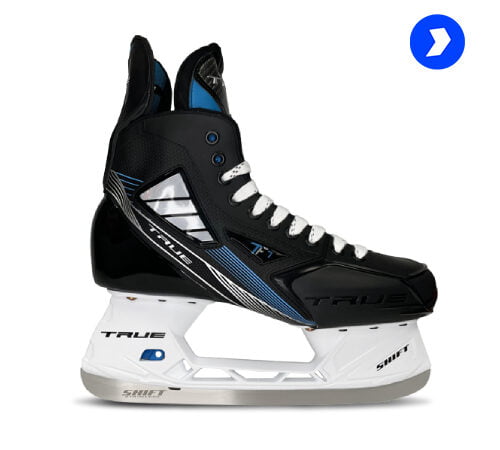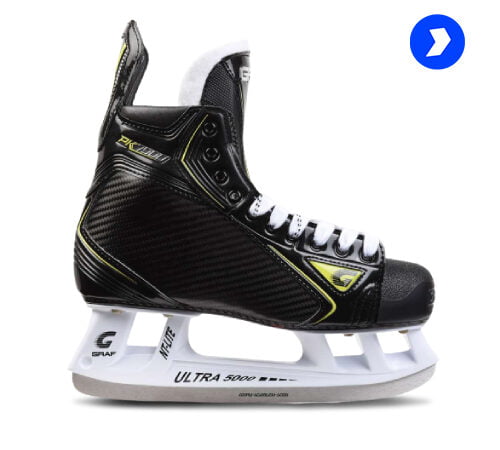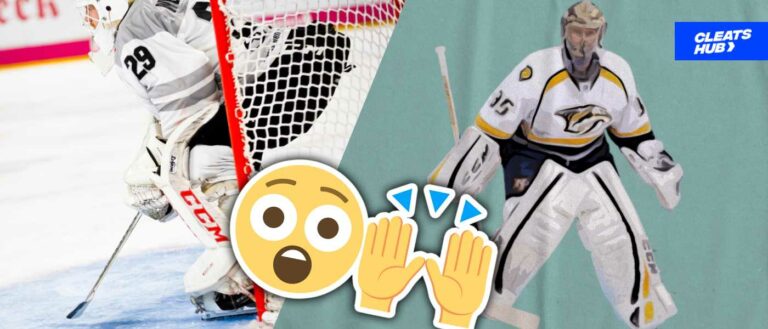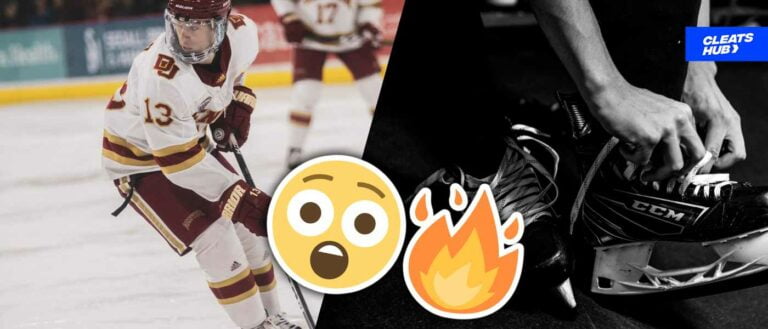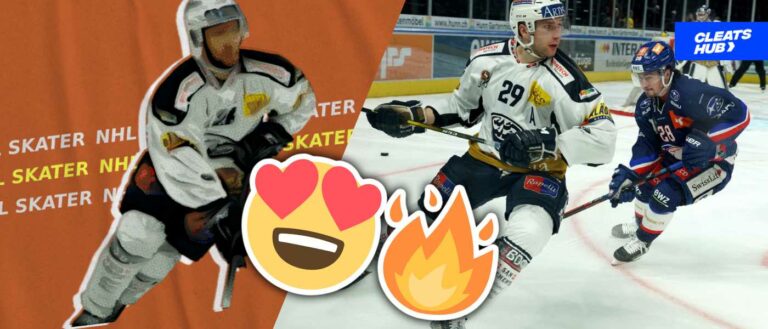What Is Icing In Ice Hockey? The Icing Rule
Today we are taking a look is one of the popular rules in ice hockey. Just like any sport, ice hockey is made up of a set of rules that order the actions of players. Among these rules is the icing rule. In this context, we’ll look at the meaning of icing in hockey, its history, variations, and exceptions.
What Is Icing In Ice Hockey?
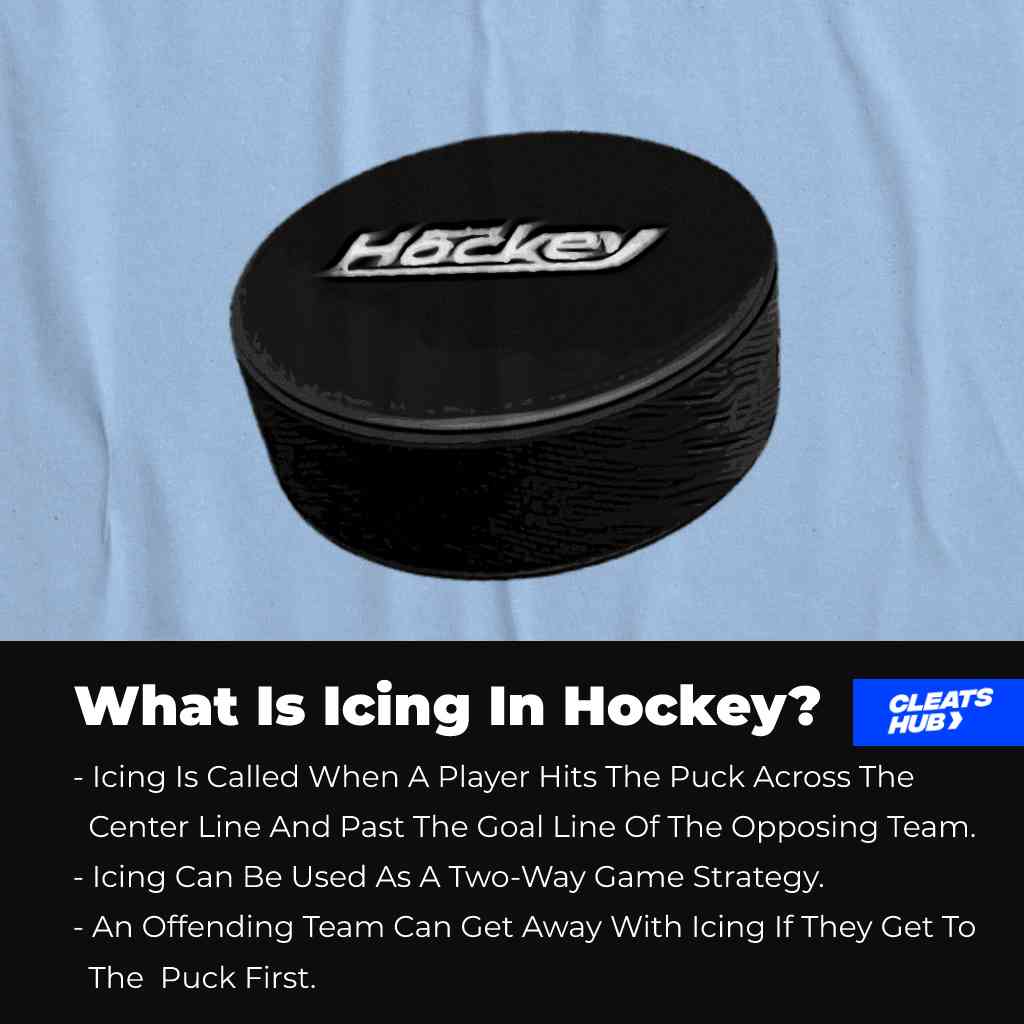
First, let’s start with the basics, what is referred to as icing in hockey?
Icing is a violation in ice hockey in which a player hits, deflects, shoots, or engages the puck with his hand or stick, causing the puck to cross the red center line and red goal line of the opposing team without having contact with other players.
An offending team can get away with an icing violation if any player from their team gets to the puck first.
Icing is sometimes a two-way strategy in which teams have the option of:
- Icing the puck and allowing the defensemen to catch a breather and recover. Or, in some cases dumping it in to delay the game. This is especially common as a strategy for shorthanded teams.
- In another way, it is a good offensive tactic if a player from the team that iced the puck is able to get to the puck first to break the icing (this will be explained later on).
The term “icing the puck” explains that a player has committed icing by shooting the puck over the red center line and the opposing team’s goal line.
Related Post: What Are The Basic Rules Of Ice Hockey?
Referee Signal
Icing is not ruled right away if a player shoots the puck across the red center line and red goal line. At this point, icing is said to be pending. The linesman signals the impending icing by raising a hand when this occurs.
If icing is called, the team of the first player to touch the puck will be the deciding factor. Icing is called off if the first player is a member of the team that iced the puck. The referee lowers his hands and signals washout which means the icing has been suspended.
The referee makes the washout indication by extending his hands sideways until his shoulder and hands are horizontal.
However, if a member of the other side is the first to touch the puck, a stoppage is signaled by blowing the whistle showing that the icing violation has been activated. After that, a faceoff is conducted at a faceoff point in the other team’s defensive zone.
History Of Icing In Hockey
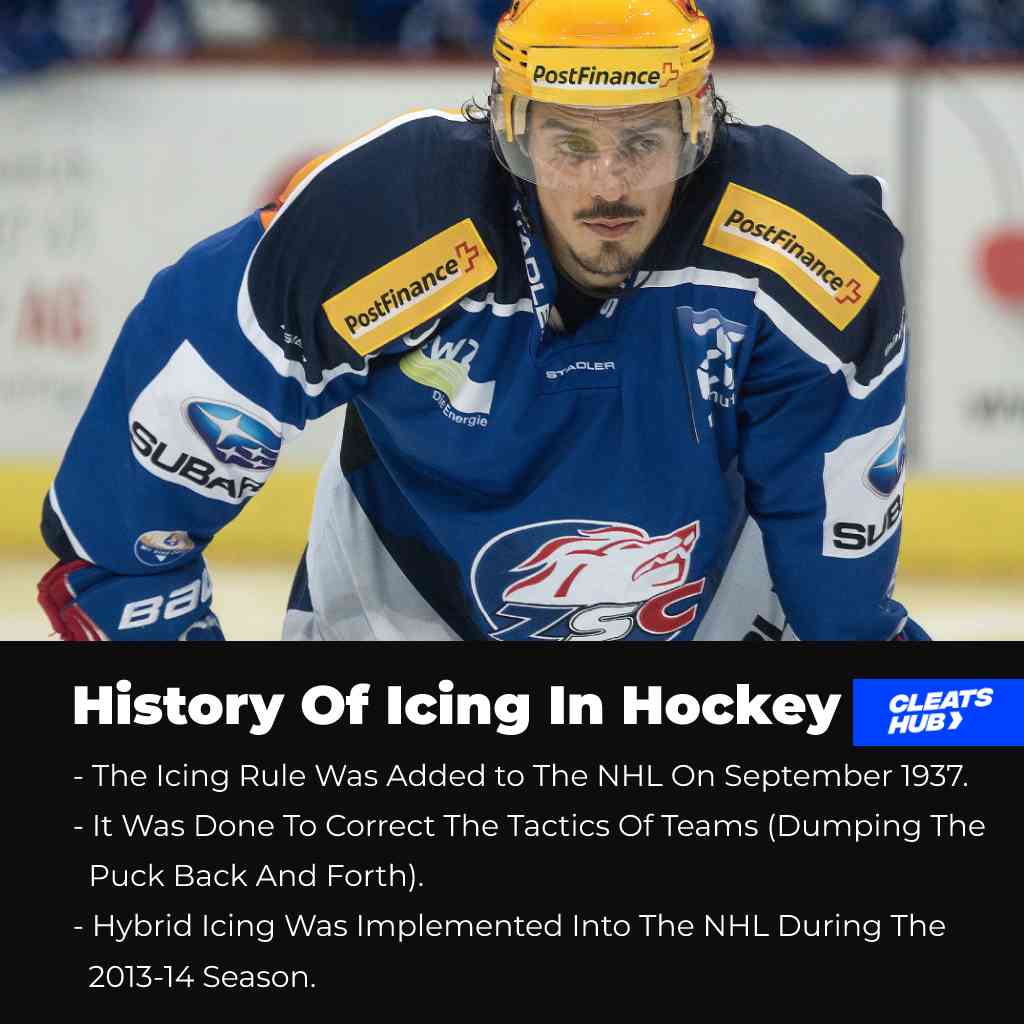
In September 1937, the NHL adopted the icing regulation. It was included in the regulation as a result of the strategies teams employed to make sure that they maintained a goal advantage over a rival side.
This strategy involves frequently throwing the puck from one end of the rink to the other. This back-and-forth strategy prevented forwards from using their assault formulae constructively and led to dull games.
Boston Bruins and New York Americans contests are two well-known examples of games when the puck was iced several times. The New York Americans iced the puck a total of 50 times in one game to guarantee that they kept their 3-2 advantage. This caused onlookers to hurl rubbish onto the ice.
This, however, paled in comparison to when they played the next time. The game finished without a score, and the Bruins iced the puck 87 times to guarantee they had their retribution.
The NHL implementing the icing regulation is partially because of these occurrences. In hockey, icing has seen a number of changes during the past year.
According to a change made in 1951, whenever the opponent’s goalkeeper touches the puck when icing is pending, it will automatically be called off. Moreover, hybrid icing was introduced to the NHL for the 2013–14 season.
Variations Of Icing In Hockey

There are three variations of icing in hockey. These variations were due to the different implementations and rule changes to icing in ice hockey. The three variations of icing in hockey include:
- Touch Icing
- No-Touch Icing or Automatic Icing
- Hybrid Icing
Touch Icing
In touch Icing, any player from the non-offending team (except the goaltender) who gets to the puck first will result in an icing penalty for the guilty team. As a result, players from both teams will scram to get to the puck. This is before, while the opposing team is trying to activate the icing penalty, the offending team is trying to call it off.
Several player injuries were noted during touch icing, some of which involved concussions from smashing into the boards or colliding with opponents. In addition, the reason for this was because it worked on the principle of the first player to touch the puck with their stick.
This icing variation was reexamined in light of the fact that a player for the Czechoslovak First Ice Hockey League died as a result of a spine injury sustained when he crashed into a board during an icing occurrence.
No-Touch Icing
Touch icing was replaced with no-touch icing in this process. In this method of icing, there is no place for icing to be suspended. It is a more direct technique.
Under no-touch icing, the whistle for a game stoppage is blown as soon as the puck passes the opponent’s center line and red goal line.
Players do not have to chase after the puck to attempt to keep or suspend an icing infraction in no-touch icing.
Since it eliminates the potential of injury, no-touch icing is still utilized by amateur hockey leagues in the United States in place of contact icing.
Hybrid Icing
Hybrid icing comes last. Touch icing guidelines and hybrid icing regulations are extremely similar. However, under hybrid icing, the team of the first player to reach the closest playoff slot determines whether an icing infraction is called or suspended.
This is an upgrade and modification from touch icing however, it has less risk of injuries. The reason is because of the way it works.
Unlike touch icing, the first player reaching the hash mark in the playoff circle closest to where the puck was iced determines the call. In this situation, whoever the referee feels got to the closest playoff circle gets control if he calls or suspends an icing infraction.
Hockey Icing Rule
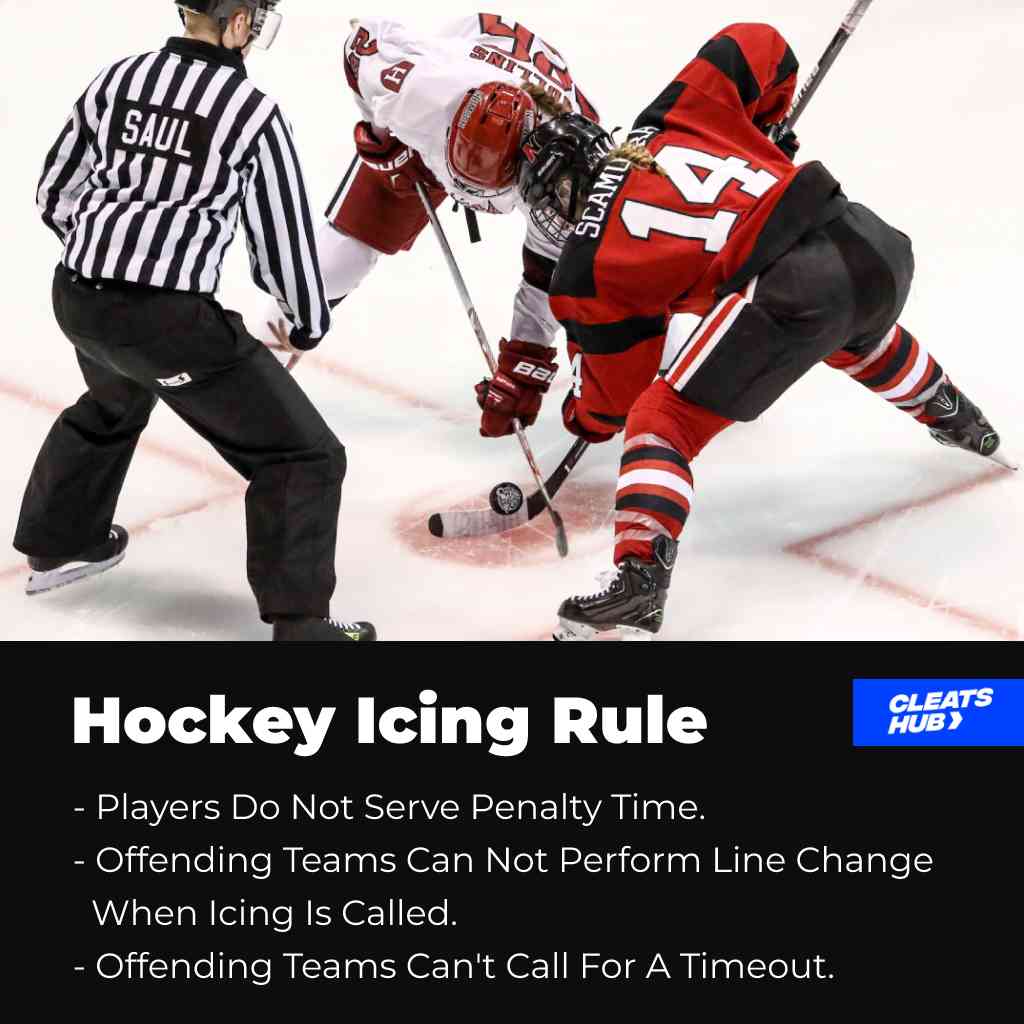
Ice hockey players do not spend time in the penalty box even if icing is a rule violation. A faceoff is conducted at the faceoff circle in the opposing team’s defensive zone if icing is called against a team.
However, the exception that permits a team to ice the puck is when the team is shorthanded. It is allowed because the shorthanded team is short on players due to the man advantage the opposing team enjoys from the powerplay.
The offending side is not permitted to make any line change to the players on the ice when icing is called. Also, when icing is called against one of its players, a team cannot call a timeout.
It works well as a powerplay breaker. Aside from these, there are some other exceptions to icing in ice hockey.
Exception To Icing In Hockey
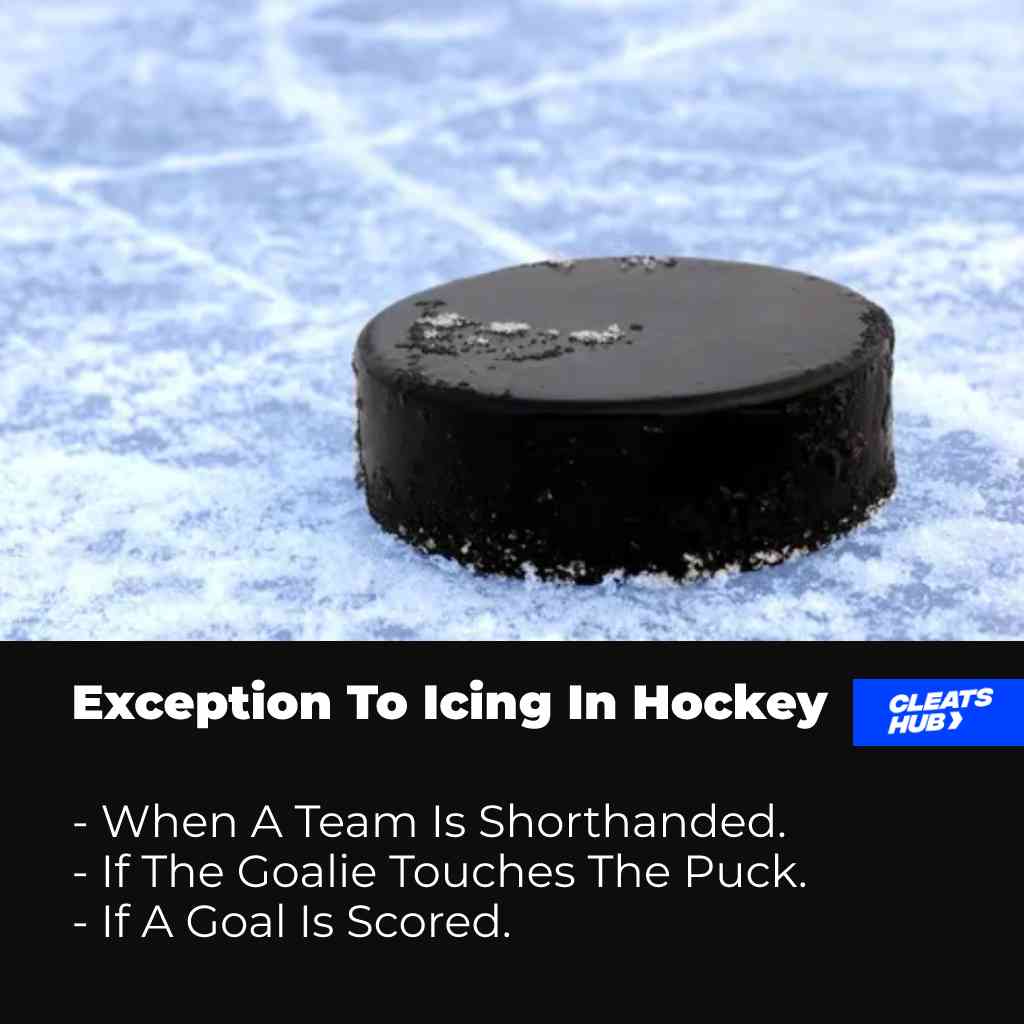
The following is a list of times when icing is not called, even if a player ice the puck.
- When one or more players are serving penalty (a shorthanded team). However, the United States’ under-14 age categories are exempt from this restriction.
- Goaltender contact with the puck does not result in an icing call.
- Icing is not signaled if a goaltender leaves the goalie crease to collect the puck. Once more, this is not in accordance with US Hockey regulations.
- Moreover, icing is not called if a player from the opposing team—aside from the goalie—is thought to have been able to stop the icing offense from happening. This implies that icing is not called if a member of the opposing team had the chance to stop the puck before it crossed the line but declined to do so.
- Whenever a player strikes the puck while standing on the red center line
- If a goal is scored, icing is not called. A goal is given when a puck that has been iced crosses the goal line and enters the net rather than icing being called.
- Faceoff with the puck being iced.
- As mentioned under touch and hybrid icing, icing is not called if the offending team reaches the puck or faceoff area first.
Conclusion
All of this relates to the origins, regulations, and exceptions of icing in hockey. Fortunately, the NHL and many other leagues are presently using the hybrid icing option.
It is popular due to its lower injury rate and the exhilaration viewers experience as players chase the puck. I hope you now have a solid understanding of the fundamentals of icing in NHL ice hockey.
Thanks for reading.
Psstt…. The Top Performing Cleats
Psstt…. The Top Performing Cleats


